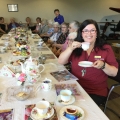
Have you ever left an event feeling exhausted and overstimulated? Residents often experience this as they move from one group activity to another with little time in between. A bit of silence to rest and recover can go a long way!
In this article we cover:
- A Day in the Life of Residents
- 6 Benefits of Silence and Solitude
- Talk about the Benefits of Silence with Residents
- 4 Group Activities Incorporating Silence
- Individual Silence and Solitude Inspiration
- Silence as a Gateway to Health
Related Activities
Comments Post a Comment
Rev Joseph  30th Mar 2022
Chaplain
30th Mar 2022
Chaplain
 30th Mar 2022
Chaplain
30th Mar 2022
Chaplain
Drawing from the Article : Silence as an Oasis,Stiver, Tanya, N.J. Enfield, P. Brown, et.al., Universals and cultural variation in turn-taking in conversation, Proceedings of the National Academy of Sciences of the United States of America, Vol. 106, No. 26 ' Silent moments in therapy serve as an oasis from the chatter that fills most of our lives. Like an oasis, supportive silences can refresh, nurture and strengthen those around it. Because such spaces in conversation are outside usual human interactions, they can let something different happen. They are a powerful tool that we each need to develop thoughtfully and purposefully.' This explains how we get new revelations during our quiet moments. According to the scriptures , Jesus often withdrew himself from his followers to a solitary place to pray and to hear from God. At times we need allow silence to communicate with the service Users as long as we remain alert of their circumstances.

Susan  31st Mar 2022
Activity Director
31st Mar 2022
Activity Director
 31st Mar 2022
Activity Director
31st Mar 2022
Activity Director
Thanks for your input Rev Joseph

Olwyn  17th May 2019
Diversional Therapist
17th May 2019
Diversional Therapist
 17th May 2019
Diversional Therapist
17th May 2019
Diversional Therapist
Lovely ideas here. Thank you Haley. Overstimulation can definitely be a problem. Some days in the afternoon, right after the lunchtime meal, I put a youtube movie on of fish in a fish tank, with no sound. Even the medical and allied staff enjoy this hour of peacefulness. There are many similar videos such as waterfalls, or waves crashing on a beach on Youtube. I have also found some DVD's in the Op shop thrift stores.
Haley  21st May 2019
Recreation Therapist And Writer
21st May 2019
Recreation Therapist And Writer
 21st May 2019
Recreation Therapist And Writer
21st May 2019
Recreation Therapist And Writer
Great idea, Olywn! I'm sure it adds a peaceful element in your community during a chaotic time (meals are always loud and bustling).

AJ  17th May 2019
Activity Director
17th May 2019
Activity Director
 17th May 2019
Activity Director
17th May 2019
Activity Director
Yes, the days of "activities as a party atmosphere all day everyday" are so outdated. We have leisure reading, at 2:30 everyday where residents can come in browse newspaper, magazines, do a word search puzzle, etc. 3x a week (during the winter months) we have coffee cafe where it is a coffee house atmosphere, light music in the back ground, coffee/tea/hot apple cider are served. Things dont always have to be loud, bright and in motion to be an activity!
Haley  21st May 2019
Recreation Therapist And Writer
21st May 2019
Recreation Therapist And Writer
 21st May 2019
Recreation Therapist And Writer
21st May 2019
Recreation Therapist And Writer
I completely agree, AJ. I'm also glad that we can meet the needs of our residents in a variety of different ways, since everyone is unique. Love your coffee shop idea as well - keep up the good work!

Kim  14th May 2019
lifestyle
14th May 2019
lifestyle
 14th May 2019
lifestyle
14th May 2019
lifestyle
I just can't love this enough. Personally I am a big believer in silence and find that our residents can be over stimulated which therefore causes " behaviours" . I like to have a peaceful setting for our activities and read the feeling in the room before we decide to play music or chat. Myself in social situations where there is so much noise and commotion going on I feel anxious and angry at times so can completely understand how this would affect our residents on a daily basis. This is a great read and very informative. Well done.
Haley  15th May 2019
Recreation Therapist And Writer
15th May 2019
Recreation Therapist And Writer
 15th May 2019
Recreation Therapist And Writer
15th May 2019
Recreation Therapist And Writer
Thanks for the feedback, Kim! Like you, I find myself overwhelmed and overstimulated during busy events or in big crowds - our residents likely feel that way sometimes too. Thankful you already see the benefits of peaceful settings - your residents are better for it!
Jo Elise  11th May 2019
Therapist
11th May 2019
Therapist
 11th May 2019
Therapist
11th May 2019
Therapist
brilliant!
Haley  15th May 2019
Recreation Therapist And Writer
15th May 2019
Recreation Therapist And Writer
 15th May 2019
Recreation Therapist And Writer
15th May 2019
Recreation Therapist And Writer
Glad you enjoyed this article, Jo! Here's to peaceful moments for you and your residents.

Haley  10th May 2019
Recreation Therapist And Writer
10th May 2019
Recreation Therapist And Writer
 10th May 2019
Recreation Therapist And Writer
10th May 2019
Recreation Therapist And Writer
Haley has submitted a new article: The Health Benefits of Silence in Senior Care

 By
By 
 6 Tips for Writing a Self-Assessment
6 Tips for Writing a Self-Assessment
 15+ Ways to Find Intergenerational Partners
15+ Ways to Find Intergenerational Partners
 6 Spring Art Activities Your Residents Will Love
6 Spring Art Activities Your Residents Will Love
 10 Easy-to-Grow Indoor Plants for the Elderly
10 Easy-to-Grow Indoor Plants for the Elderly


Thanks!